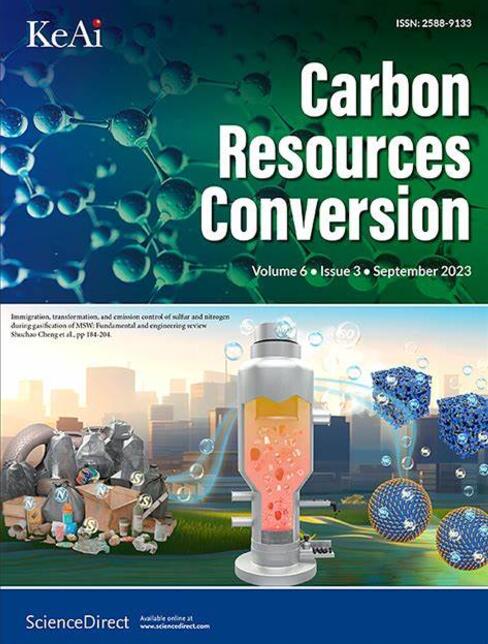Optimizing bioethanol production from sweet sorghum stem juice under very high gravity fermentation and temperature stress conditions
IF 7.5
3区 环境科学与生态学
Q2 ENERGY & FUELS
引用次数: 0
Abstract
This study optimized ethanol production from sweet sorghum stem juice (SSJ) by Saccharomyces cerevisiae NP01 under very high gravity (VHG) fermentation in 500-mL air–locked flasks at 30 °C. Response surface methodology based on a Box-Behnken design was employed to optimize initial sugar (267 g/L), urea (3.24 g/L), and cell concentration (1.32 × 108 cells/mL) for maximization of ethanol concentration (PE), productivity (QP), and sugar consumption (%SC). The experimental values (PE, 119.29 g/L; QP, 2.49 g/L.h and %SC, 91.83 %) under optimal conditions were close to the predicted values, verifying the optimization process. Aeration (2.5 vvm for 4 h) increased viable cell counts and decreased glycerol production (a by-product), but not fermentation efficiency. An osmoprotectant (40 mM potassium chloride combined with 10 mM potassium hydroxide, KCl/KOH) at 30 °C had no positive effect on ethanol fermentation efficiency. However, at 25 °C, the osmoprotectant increased PE from 106 to 116 g/L and ethanol yield from 0.46 to 0.49 g/g. At 35–37 °C, it prolonged cell viability, increasing PE by 5–12 g/L and %SC by 3–8 % without affecting ethanol yield. However, at 39 °C, no positive impact occurred on ethanol fermentation efficiency. The findings from this study, particularly the optimized fermentation conditions and stress tolerance strategies, could guide the scale-up to an industrial level of bioethanol production from sweet sorghum stem juice or other feedstocks using VHG fermentation, contributing to the development of more efficient and sustainable biofuel production processes.

高重力发酵和温度胁迫条件下甜高粱茎汁生产生物乙醇的优化研究
本研究优化了酿酒酵母NP01以甜高粱茎汁为原料,在30℃、500 ml的密闭烧瓶中高重力发酵生产乙醇的工艺条件。基于Box-Behnken设计的响应面法优化初始糖(267 g/L)、尿素(3.24 g/L)和细胞浓度(1.32 × 108个细胞/mL),以最大限度地提高乙醇浓度(PE)、产率(QP)和糖消耗(%SC)。实验值(PE, 119.29 g/L;最优条件下QP为2.49 g/ l h, SC %为91.83%)接近预测值,验证了优化过程。曝气(2.5 vvm, 4 h)可增加活细胞数,降低副产物甘油的产量,但不能提高发酵效率。40 mM氯化钾与10 mM氢氧化钾(KCl/KOH)在30℃条件下的渗透保护剂对乙醇发酵效率无显著影响。然而,在25°C时,渗透保护剂将PE从106提高到116 g/L,乙醇产量从0.46提高到0.49 g/g。在35-37℃下,延长了细胞活力,PE提高了5-12 g/L, SC提高了3 - 8%,而乙醇产量不受影响。然而,在39°C时,对乙醇发酵效率没有正面影响。本研究的发现,特别是优化的发酵条件和耐受性策略,可以指导利用VHG发酵从甜高粱茎汁或其他原料生产生物乙醇的规模扩大到工业水平,有助于开发更高效和可持续的生物燃料生产工艺。
本文章由计算机程序翻译,如有差异,请以英文原文为准。
求助全文
约1分钟内获得全文
求助全文
来源期刊

Carbon Resources Conversion
Materials Science-Materials Science (miscellaneous)
CiteScore
9.90
自引率
11.70%
发文量
36
审稿时长
10 weeks
期刊介绍:
Carbon Resources Conversion (CRC) publishes fundamental studies and industrial developments regarding relevant technologies aiming for the clean, efficient, value-added, and low-carbon utilization of carbon-containing resources as fuel for energy and as feedstock for materials or chemicals from, for example, fossil fuels, biomass, syngas, CO2, hydrocarbons, and organic wastes via physical, thermal, chemical, biological, and other technical methods. CRC also publishes scientific and engineering studies on resource characterization and pretreatment, carbon material innovation and production, clean technologies related to carbon resource conversion and utilization, and various process-supporting technologies, including on-line or off-line measurement and monitoring, modeling, simulations focused on safe and efficient process operation and control, and process and equipment optimization.
 求助内容:
求助内容: 应助结果提醒方式:
应助结果提醒方式:


